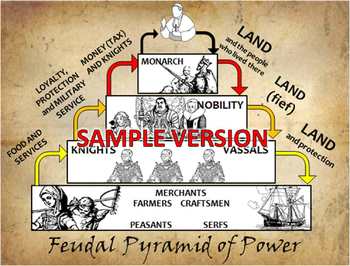

The feudal system rested on the unsettled conditions of the times and thus on the need of the lord for armed warriors and the need of the vassal for protection. With the advent of hereditary succession and primogeniture, renewal of the fief by the heir of the deceased became customary, and little by little the fief became hereditary. Originally the fief had to be renewed on the death of either party. Thus very complex relationships, based on fiefs, developed among the nobles, and the personal ties between overlords and vassals were weakened. Gradually the system of subinfeudation evolved, by which the vassal might in his turn become an overlord, granting part of his fief to one who then became vassal to him. Honors or rights, as well as land, could be granted as fiefs. This formal procedure served to cement the personal relationship between lord and vassal after the ceremony the lord invested the vassal with the fief, usually by giving him some symbol of the transferred land.

The vassal then swore an oath of fealty, vowing to be faithful to the overlord and to perform the acts and services due him. The fief was formally acquired following the ceremony of homage, in which the vassal, kneeling before the overlord, put his hands in those of the lord and declared himself his man, and the overlord bound himself by kissing the vassal and raising him to his feet. The feudal method of holding land was by fief the grantor of the fief was the suzerain, or overlord, and the recipient was the vassal. Under the manorial system the peasants, laborers, or serfs, held the land they worked from the seigneur, who granted them use of the land and his protection in return for personal services (especially on the demesne, the land he retained for his own use) and for dues (especially payment in kind). The political economy of the system was local and agricultural, and at its base was the manorial system. Beneath him was a hierarchy of nobles, the most important nobles holding land directly from the king, and the lesser from them, down to the seigneur who held a single manor.

In an ideal feudal society (a legal fiction, most nearly realized in the Crusaders' Latin Kingdom of Jerusalem), the ownership of all land was vested in the king. Although some men held their land in alod, without obligation to any person, they were exceptions to the rule in the Middle Ages. Feudalism was based on contracts made among nobles, and although it was intricately connected with the manorial system, it must be considered as distinct from it. The evolution of highly diverse forms, customs, and institutions makes it almost impossible to accurately depict feudalism as a whole, but certain components of the system may be regarded as characteristic: strict division into social classes, i.e., nobility, clergy, peasantry, and, in the later Middle Ages, burgesses private jurisdiction based on local custom and the landholding system dependent upon the fief or fee. Although analogous social systems have appeared in other civilizations, the feudalism of Europe in the Middle Ages remains the common model of feudal society. The term feudalism is derived from the Latin feodum, for “fief,” and ultimately from a Germanic word meaning “cow,” generalized to denote valuable movable property. Feudalism (fyo͞oˈdəlĭzəm), form of political and social organization typical of Western Europe from the dissolution of Charlemagne's empire to the rise of the absolute monarchies.


 0 kommentar(er)
0 kommentar(er)
